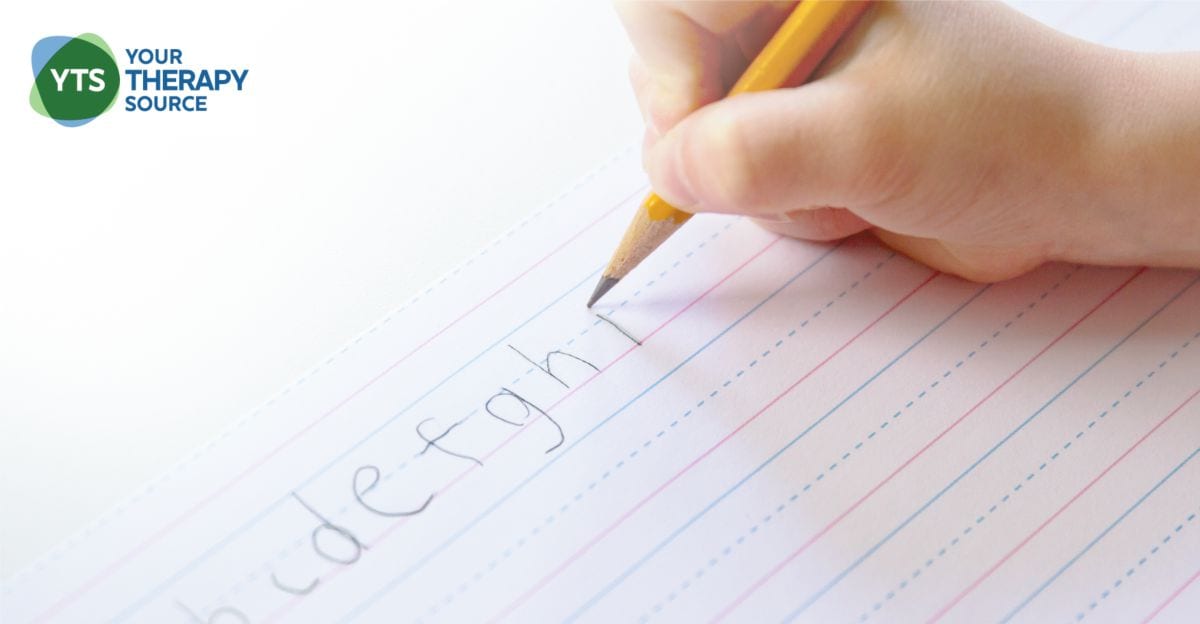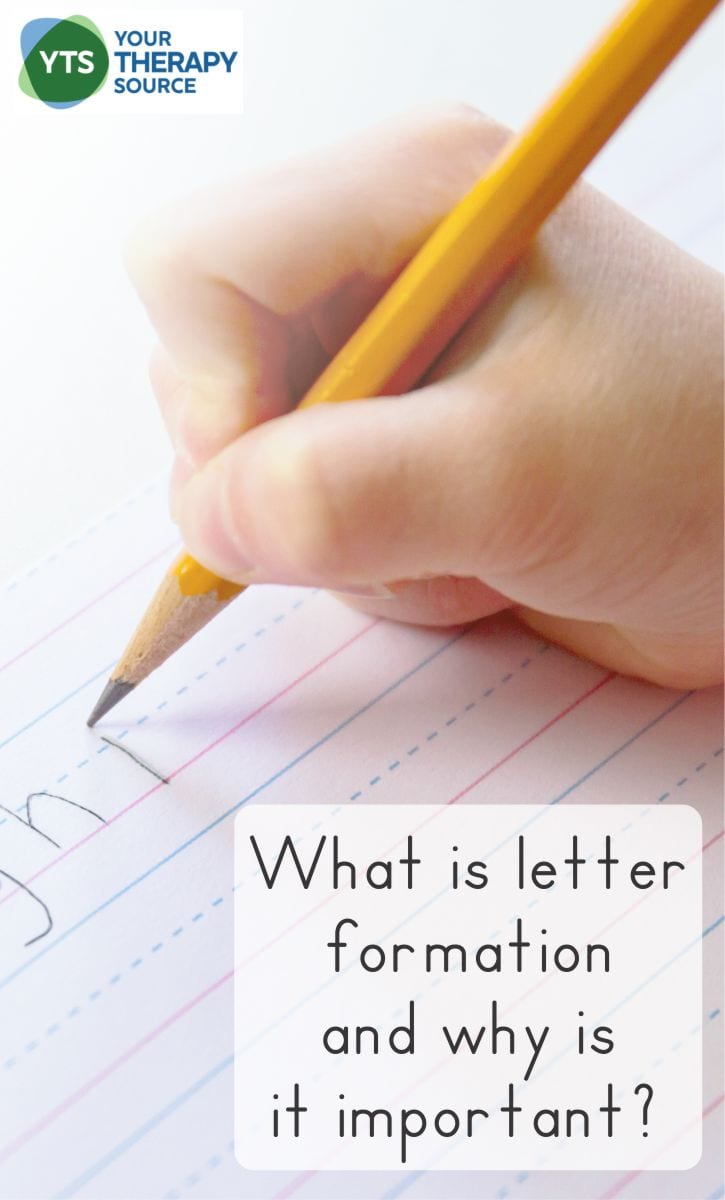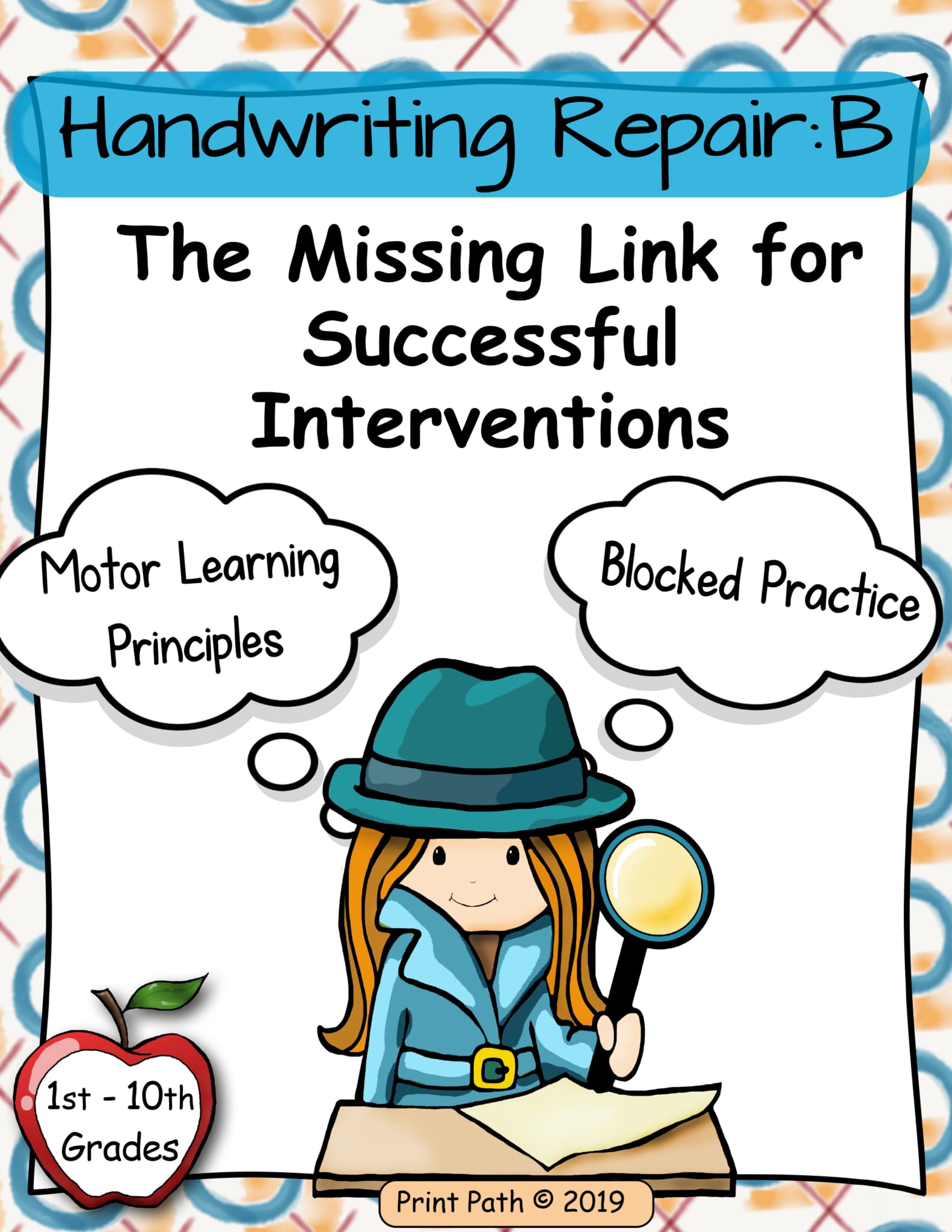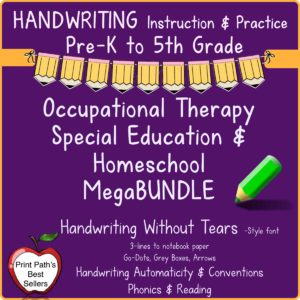What is Letter Formation and Why Is It Important?

What is letter formation and why is it so important for children to learn? You may wonder if learning how to write letters is a high priority skill during this age of technology. Well, guess what? It is extremely important for children.
Letter formation is the ability to form the letters of the alphabet correctly. Children need to be taught these skills along a continuum based on their developmental abilities.
Why is Proper Letter Formation Important?
Research reveals that there are many benefits to having legible and efficient handwriting skills such as:
- teachers give higher grades to assignments produced with more attractive writing and that are “easy to read” rather than those produced with less attractive writing.
- difficulties with handwriting may influence the writer’s attention, requiring them to focus more on the writing and less on the thought process of what to write.
- children with handwriting difficulties may develop negative experiences of writing, including frustration, decreased self-efficacy, and poor motivation.
- handwriting requires fine motor control and fine motor activities stimulate the prefrontal cortex (part of the brain that helps with self-regulation and executive function).
The Pitfalls of Teaching Letter Formation Too Early
Many times, early childhood centers and preschool are starting too early when they teach the ability to form letters of the alphabet with a pencil or other writing utensil. Many three and young four-year-old children are not developmentally ready to use a pencil to create the different strokes requires to form each letter.
At this younger age, children move along a progression of learning how to make marks on paper. At first, children begin to scribble on paper. Then children learn to make marks on paper along a timeline starting at around 2 years of age:
- vertical lines
- horizontal lines
- circle
- plus sign
- square
- diagonal lines
- X
- triangle (about 5 years+)
When we start teaching letter formation in preschool without the children having adequate fine motor skills, pre-writing skills, hand and finger strength, and visual-motor skills, bad habits can be created that can be very difficult to correct.
When is the Optimal Time to Teach Letter Formation?
In general, when children have the ability to trace, copy, and write lines, shapes, and patterns, they are ready to learn how to form letters.
Remember that students also need to identify letters in order to form letters. There are four components of letter recognition: 1.)Letter recognition – the ability to recognize the shape and size of the letter. 2.) Letter naming – recognizing that the shape of the letter is associated with a letter name. 3.) Letter sound knowledge – determining what sound corresponds to the shape or name of the letter. 4.) Letter writing – the ability to trace or write the letter with a pen in accordance with its shape and direction. (Dinehart, 2015).
Children need to learn the shape of a letter, what the letter’s name is, what the letter sounds like and how to write a letter.
How to Teach Letter Formation
A best practice is for an entire school to utilize the same handwriting curriculum so students are being taught letter formation the same way at each grade level. Research indicates that there are benefits to providing students with specific handwriting instruction.
The American Journal Of Occupational Therapy recently published a systemic review of curriculum-based handwriting programs for students in preschool through second grade. After reviewing 13 studies, the researchers identified the following:
- curriculum-based handwriting interventions resulted in small- to medium-sized improvements in legibility.
- after review of 9 handwriting curriculums, no clear support was found for one handwriting program over another.
- 6 wk of intervention (about 15 hours) may be sufficient to improve legibility. (Engel, 2018).
Educational Psychology Review published a research review on handwriting instruction. A meta-analysis was completed on experimental intervention studies with K-12 students to determine if teaching handwriting enhanced legibility and fluency and resulted in better writing performance. The results indicated the following:
- when compared to no instruction or non-handwriting instructional conditions, teaching handwriting resulted in statistically greater legibility and fluency.
- motor instruction did not produce better handwriting skills.
- individualizing handwriting instruction and teaching handwriting via technology resulted in statistically significant improvements in legibility.
- handwriting instruction produced statistically significant gains in the quality, length and fluency of students’ writing. (Santangelo, 2016)
The Journal of Occupational Therapy, Schools, and Early Intervention recently published a systemic review on handwriting acquisition and interventions for handwriting for preschoolers through second grade. The results indicated the following:
- writing letters in late preschool contributes to letter recognition.
- Elementary students do better when handwriting is explicitly taught.
- Legibility improves with adequate practice. (Fancher, 2018)
Letter Formation Practice is Key!
Providing students with multisensory lessons may help to improve letter recognition. Multisensory lessons can include visual input (looking at the shape and size of the letter), auditory input (listening to the sounds of letters, visual-motor input (writing the letter) and kinesthetic input (moving like the letter).
A key component of any successful handwriting instruction is practice! The Canadian Journal of Occupational Therapy published a review of the interventions used to improve handwriting. After reviewing 11 studies that tested relaxation and practice with or without EMG, sensory-based training without handwriting practice, and handwriting-based practice (including sensory-focused or cognitive focused handwriting practice) the researchers concluded that interventions that did not include handwriting practice and those that included less than 20 practice sessions were ineffective(Hoy, 2011).
Once a child has developed inefficient motor habits for writing, it can be very difficult to re-learn new patterns of movement. Even in occupational therapy, we can often teach a child conventional handwriting formations, but as soon as they go back to their classrooms, they use their old letters that start at the bottom, go the wrong direction, are slow to produce, and more importantly are difficult to read. We all know students who have abundant ideas to share but because of poor handwriting skills are reluctant to write. When they do write, they are not able to express their ideas or read their own handwriting.
This, Handwriting Intervention research-based method has been pivotal for children with and without visual-motor delays, including students with dysgraphia, learning disabilities, ADHD, and autism. Using these SIMPLE strategies, you will be able to make a real difference in helping clients gain automaticity of handwriting.
Handwriting Instruction Resources
Many schools use specific handwriting curriculums to help reduce variance among classrooms for handwriting instruction. At Your Therapy Source, we offer two handwriting tools and curriculums to help support letter formation and handwriting instruction.
This Handwriting Bundle for PreK-5th Graders was created by school based occupational therapist, Thia Triggs of Print Path. This Handwriting Without Tears© -style letter font, uses 3-lines to best support your students. There are Go-Dots, Gray-Boxes, and Simple Arrows that inform rather than confuse learners. Best practices include research based methods incorporating application of developmental and motor learning theories to benefit your struggling learners. Get 8 of the best handwriting instruction downloads for your multi-leveled interventions! FIND OUT MORE.
More Letter Formation Worksheets for Practice
If you need letter formation worksheets for practice check out these resources:
Visual Perceptual and Handwriting Practice Pages
Handwriting Templates with Alphabet Guides
Handwriting Interventions – Occupational Therapy Tools for Blocked Handwriting Modification
References:
Dinehart, L. H. (2015). Handwriting in early childhood education: Current research and future implications. Journal of Early Childhood Literacy, 15(1), 97-118.
Engel, C., Lillie, K., Zurawski, S., & Travers, B. G. (2018). Curriculum-Based Handwriting Programs: A Systematic Review With Effect Sizes. American Journal of Occupational Therapy, 72(3), 7203205010p1-7203205010p8.
Fancher, L. A., Priestley-Hopkins, D. A., & Jeffries, L. M. (2018). Handwriting Acquisition and Intervention: A Systematic Review. Journal of Occupational Therapy, Schools, & Early Intervention, 11(4), 454-473.
Hoy, M. M., Egan, M. Y., & Feder, K. P. (2011). A systematic review of interventions to improve handwriting. Canadian Journal of Occupational Therapy, 78(1), 13-25.
Santangelo, T. & Graham, S. A Comprehensive Meta-analysis of Handwriting Instruction. Educ Psychol Rev (2016) 28: 225. doi:10.1007/s10648-015-9335-1




